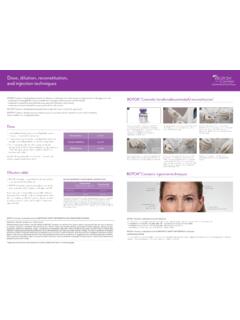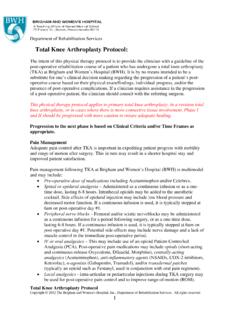Transcription of Ankle Sprain Rehabilitation Guideline General Guidelines ...
1 Ankle Sprain Rehabilitation GuidelineThis Rehabilitation program is designed to return the individual to their activities as quickly and safely as possible. It is designed for Rehabilitation following Ankle Sprain . Modifications to this Guideline may be necessary dependent on physician specific instruction, specific tissue healing timeline, chronicity of injury, and other contributing impairments that need to be addressed. This evidence-based Ankle Sprain Guideline is criterion-based; time frames and visits in each phase will vary depending on many factors including patient demographics, goals, and individual progress.
2 This Guideline is designed to progress the individual through Rehabilitation to full sport/activity participation. The therapist may modify the program appropriately depending on the individual s goals for activity following Ankle Sprain . This Guideline is intended to provide the treating clinician a frame of reference for Rehabilitation . It is not intended to substitute clinical judgment regarding the patient s post injury care, based on exam/treatment findings, individual progress, and/or the presence of concomitant injuries or complications. If the clinician should have questions regarding progressions, they should contact the referring Guidelines / Precautions: General healing timeline is variable but can expect 2-6 week time frame on averageDuring the acute phase, avoid activities that stress the ligaments on the lateral or medial surface of the foot (depending on MOI)1.
3 Laterally (most commonly injured): Anterior Talofibular Ligament, Posterior Talofibular Ligament, Calcaneofibular ligament2. Medially (less commonly injured): Superficial and Deep Deltoid Ligaments3. Syndesmotic: See High Ankle Sprain Rehabilitation guidelineGeneral ROM/strength present at the beginning of Rehabilitation is highly variablePatient is at risk for recurrent Ankle sprains and development of chronic Ankle instabilityRule out fracture and/or need for further imaging through utilization of the Ottawa Ankle Rules (exclude children under 6 or pregnant women)1. Bone tenderness along the distal 6 cm of the posterior edge of the tibia or tip of the medial malleolus2.
4 Bone tenderness along the distal 6 cm of the posterior edge of the fibula or tip of the lateral malleolus3. Bone tenderness at the base of the fifth metatarsal and/or navicular4. An inability to bear weight both immediately and in the emergency department for four stepsAvoid activities which increase pain and/or swellingSanford Total Ankle Arthroplasty Physical Therapy Post-Operative GuidelinesWEEKSUGESSETED INTERVENTIONSGOALSP hase IProtection PhaseDiscuss:Anatomy, existing pathology, rehab schedule, and expected Instructions: Do not perform activities that increase pain and/or swellingGoals of Phase:1.
5 Diminish pain and inflammation2. Improve flexibility and range of motion0-2 WeeksSuggested Treatments: Modalities as indicated: Ice, compression, elevation, electrical stimulation ROM: PROM, AAROM, AROM within pain free range Protection: Protect ligaments from further trauma through use of taping, splinting, orthotics, braces, or casts in severe instances based on clinical judgement and patient presentation WBAT: Utilize assistive device as deemed appropriate for normalization of gait patternCriteria to Advance to Next Phase:1. Normal gait pattern without use of assistive device2. Edema reduction with comparable circumferential measurements +- 1-3 cm to opposite extremitySanford Total Ankle Arthroplasty Physical Therapy Post-Operative GuidelinesWEEKSUGESSETED INTERVENTIONSGOALS0-4 Expected VisitsExercise Examples: Ankle alphabet PROM in all Ankle planes Gastroc/soleus stretching Gait training with various AD s progressing to no AD based on pain level Modalities for pain relief and edema controlOther Activities.
6 May perform core, hip, and knee strengthening exercises for proximal stabilization if deemed appropriatePhase IIProgressive ROM and Early StrengtheningSpecific Instructions: Do not perform exercises that increase pain and/or swellingSuggested Treatments:Goals of Phase:1. Improve muscular strength and endurance2. Progress to full active and passive ROM3. Improve total body proprioception and control1-3 Weeks 2-6 Expected VisitsModalities as indicated: Edema and pain controlling treatmentsROM: AROM Strengthening: Isometric, eccentric, or concentric exercises in pain free range with/without weight bearing as deemed appropriateManual therapy: talocrural and subtalar joint glides for improved DF/PF and General Ankle mobilityExercise Examples.
7 DF/PF/Inv/Ev theraband exercises in pain free range Foot intrinsic strengthening Ankle Isometrics Squats stable surface Lunges stable surface Calf Raises Toe Raises Single leg stance with stable/unstable surface and eyes open/eyes closed BAPS board (*utilize seated if not able to tolerate standing) Rocker board Treadmill walking Biking Pool ProgramOther Activities: Progress core, hip, and knee strengthening exercises with focus on stabilization if deemed appropriateCriteria to Advance to Next Phase:1. Normal gait pattern without use of assistive device2. Edema reduction with comparable circumferential measurements +- 1-3 cm to opposite extremityPhase IIIA dvanced Strengthening & neuromuscular control2-6 Weeks4-16 Expected visitsSpecific Instructions:Continue with previous exercise program; ensure core/hip stability.
8 Symmetrical strength of 5/5 should be present in both hip abductors and extensorsModalities only as neededIf no sport to return to, consider option of independent program after completion of this phaseSuggested Treatments: Manual Therapy: Soft tissue work, talocrural and subtalar glides for improved Ankle : Strengthening, proprioceptive, and beginner agility/power exercisesExercise Examples: Standing BAPs board Treadmill running with varying inclines Resisted side stepping BOSU squats BOSU lunges Front/side plank with progressions Bridging with progressions Double leg hopping forward, backward, sideways Dry land jogging/runningOther Activities: Begin practice with sport activity in controlled environment with additional support as deemed necessary (ex.)
9 Taping, braces)Goals of Phase:1. Return to strength training with appropriate modifications2. Improve muscular power, speed, agility, and neuromuscular control3. Improve proper body mechanics and movement patterns4. Increase overall proximal stabilityCriteria to Advance to the Next Phase:1. Ankle strength within 90% of uninvolved Ankle with pain free Ankle eversion on resisted isometric2. Able to perform light running with no gait abnormalities3. Able to SLS for 1 minute without loss of balance on involved limbREFERENCES:1. Garrick JG. The frequency of injury, mechanism of injury, and epidemiology of Ankle sprains.
10 Am J Sports Med. 1977;5 Hockenbury, RT, Sammarco, GJ. Evaluation and treatment of Ankle sprains: Clinical recommendations for a positive outcome. The Physician and Sportsmedicine [online]. 2001;29(2).3. Hubbard TJ, Cordova M. Mechanical instability after an acute lateral Ankle Sprain . Arch Phys Med Rehabil. 2009;90 Willems T, Witvrouw E, Verstuyft J, Vaes P, De Clercq D. Proprioception and muscle strength in subjects with a history of Ankle sprains and chronic instability. J Athl Train. 2002;37 Van Os AG, Bierma-Zeinstra SM, Verhagen AP, de Bie RA, Luijsterburg PA, Koes BW. Comparison of conventional treatment and supervised Rehabilitation for treatment of acute lateral Ankle sprains: A systematic review of the literature.









